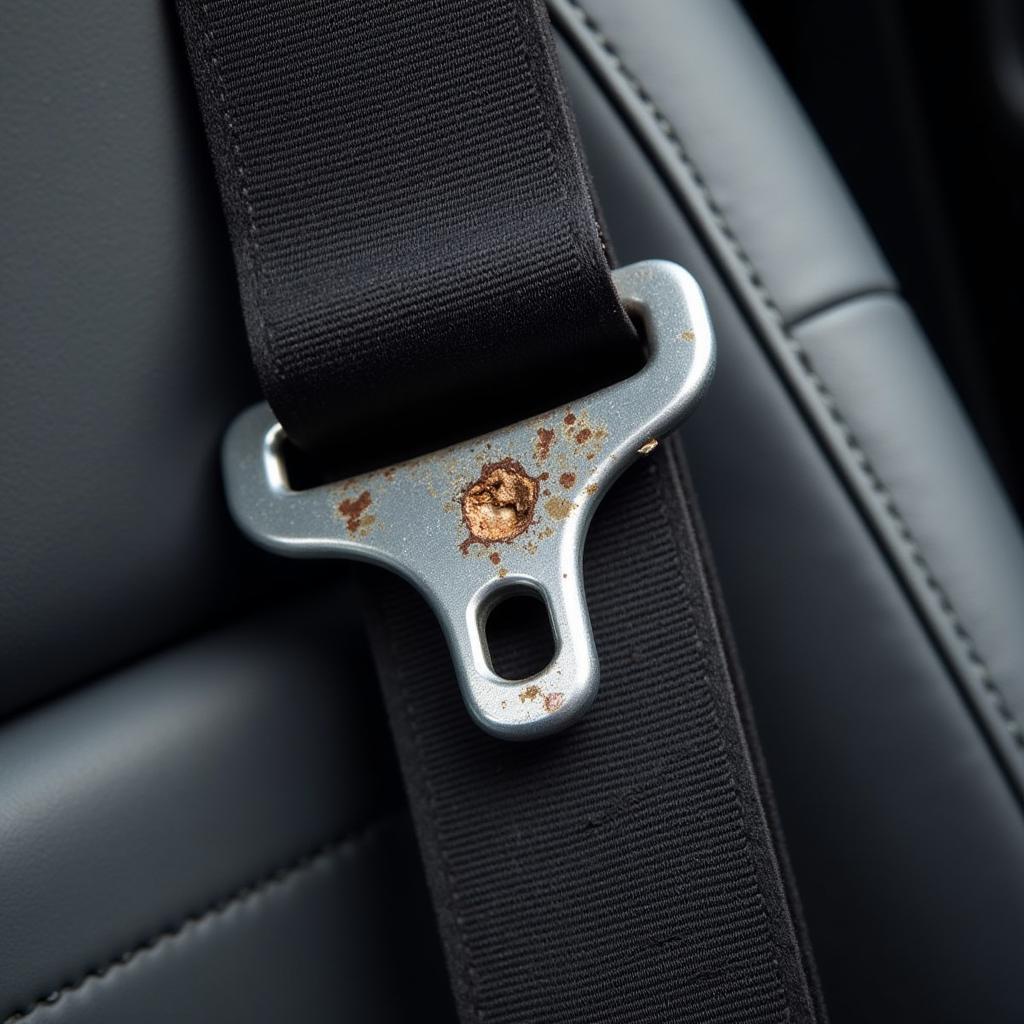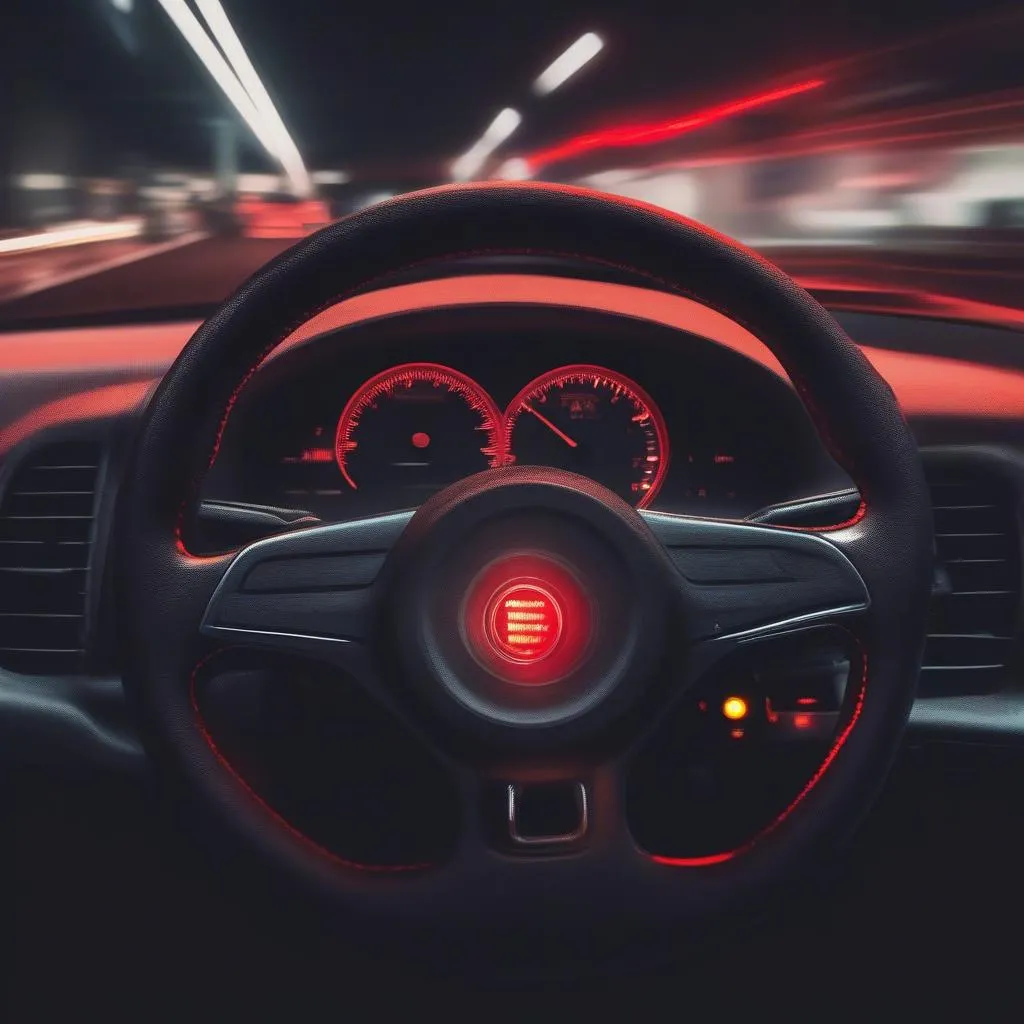The “shoe and brake pedal” warning light on your Nissan dashboard might seem unusual, but it’s actually a crucial safety indicator related to your braking system. This light, often appearing as a circle with a shoe imprint inside and an exclamation mark, signals a potential issue with your vehicle’s electronic brake force distribution (EBD) system or anti-lock braking system (ABS). Ignoring this warning could compromise your car’s braking performance and put you at risk.
 Nissan Shoe and Brake Pedal Warning Light
Nissan Shoe and Brake Pedal Warning Light
Understanding Your Nissan’s Braking Systems
Electronic Brake Force Distribution (EBD): EBD works in conjunction with your ABS, automatically adjusting the braking force applied to each wheel based on factors like vehicle load and road conditions. This ensures optimal braking performance and stability.
Anti-lock Braking System (ABS): The ABS prevents your wheels from locking up during hard braking, allowing you to maintain steering control and avoid skidding.
When the “shoe and brake pedal” warning light illuminates, it typically indicates a fault detected within these systems.
Common Causes of the Shoe and Brake Pedal Warning Light
Several factors can trigger the “shoe and brake pedal” warning light in your Nissan. Here are some of the most common culprits:
Faulty ABS Wheel Speed Sensor:
The ABS relies on wheel speed sensors to monitor the rotational speed of each wheel. A malfunctioning sensor can disrupt this process, causing the warning light to activate.
How it happens: Wheel speed sensors can fail due to damage from road debris, corrosion, or general wear and tear.
What you might experience: Besides the warning light, you might notice erratic ABS behavior, such as the system engaging unexpectedly or not functioning at all.
Low Brake Fluid Level:
Brake fluid is essential for transmitting force from your brake pedal to the brakes themselves. A low fluid level can impact braking performance and trigger the warning light.
Why it’s crucial: Low brake fluid often indicates a leak in your braking system, which needs immediate attention.
What to look for: Check your brake fluid reservoir; if the level is below the minimum mark, it needs to be topped up.
Malfunctioning ABS Module:
The ABS module is the brain of your anti-lock braking system. If this electronic component fails, it can disrupt the entire system.
How it happens: Electrical issues, exposure to moisture, or general component failure can lead to a malfunctioning ABS module.
What you might experience: Intermittent ABS activation, complete ABS failure, or other unusual braking behavior can point towards a faulty module.
Brake Pad Wear:
While not directly related to the EBD or ABS systems, worn-out brake pads can trigger the “shoe and brake pedal” warning light in some Nissan models. This is because excessively worn pads can affect brake pedal travel, which might be interpreted as a system fault.
Why it matters: Worn brake pads significantly reduce your stopping power and should be replaced immediately.
What to check: Consult your Nissan’s owner’s manual for recommended brake pad replacement intervals and inspect your brake pads regularly for wear.
What to Do When the Warning Light Illuminates
Seeing the “shoe and brake pedal” warning light on your dashboard shouldn’t be ignored. Here are the steps you should take:
- Proceed with Caution: While your conventional brakes might still function, it’s crucial to drive cautiously. Avoid hard braking and maintain a safe distance from other vehicles.
- Check Your Brake Fluid: If you feel comfortable doing so, carefully inspect your brake fluid level. If it’s low, topping it up might temporarily address the issue, but it’s essential to have the system checked for leaks by a professional.
- Schedule a Professional Diagnosis: The “shoe and brake pedal” warning light often requires specialized diagnostic tools to pinpoint the exact cause. Schedule an appointment with a qualified Nissan mechanic or dealership as soon as possible.
Remote Diagnostic Solutions for Nissan Vehicles
In today’s technologically advanced automotive landscape, remote diagnostics and software solutions play a crucial role in addressing vehicle issues, including those related to the “shoe and brake pedal” warning light.
Remote Diagnostics: Some Nissan models are equipped with telematics systems that allow for remote diagnostics. If your vehicle experiences a fault, data is transmitted to Nissan, who can then analyze the issue and advise on necessary actions. This can be especially beneficial for quickly identifying the problem and potentially avoiding unnecessary trips to the mechanic.
Software Updates and Reprogramming: Modern vehicles rely heavily on software, and occasionally, software glitches can trigger warning lights or affect system performance. Nissan regularly releases software updates to address bugs and improve vehicle functionality. In some cases, a simple software update or reprogramming of your vehicle’s ABS module might be sufficient to resolve the issue.
“Remote diagnostics and software solutions offer Nissan owners a proactive and convenient approach to vehicle maintenance. By leveraging these technologies, we can identify and address potential issues before they escalate, ensuring our customers’ safety and peace of mind.” – [Expert Name], Senior Automotive Diagnostic Technician at [Reputable Automotive Service Center]
Preventing Future Issues
While some causes of the “shoe and brake pedal” warning light, like sensor failure, are difficult to predict, you can take proactive steps to maintain your Nissan’s braking system:
- Regular Brake Fluid Checks and Flushes: Refer to your owner’s manual for recommended brake fluid flush intervals. Fresh brake fluid helps maintain optimal braking performance and prevents internal corrosion within the system.
- Timely Brake Pad Replacement: Don’t wait for your brake pads to wear out completely. Regular inspections and timely replacements ensure consistent braking performance and can prevent potential damage to other braking components.
- Adherence to Scheduled Maintenance: Following your Nissan’s recommended maintenance schedule ensures your vehicle receives timely inspections and necessary services, helping to prevent potential issues before they arise.
FAQ:
- Can I drive my Nissan with the “shoe and brake pedal” warning light on?
While your conventional brakes might still function, it’s not recommended to drive for extended periods or at high speeds with this warning light illuminated. - How much does it cost to fix the “shoe and brake pedal” warning light?
The cost varies depending on the underlying cause. A simple sensor replacement might be relatively inexpensive, while a faulty ABS module can be more costly. - Is it safe to ignore the warning light if my brakes seem to be working fine?
No, ignoring the warning light can be risky. Even if your brakes seem to be functioning normally, there could be an underlying issue that worsens over time, potentially compromising your safety. - Can I fix the problem myself?
While some car owners might have mechanical skills, it’s generally recommended to have a professional diagnose and repair braking system issues. - How long does it take to diagnose and fix the problem?
The diagnosis and repair time depends on the specific issue. A straightforward sensor replacement might be completed within a few hours, while more complex issues could require more time.
The “shoe and brake pedal” warning light in your Nissan is a crucial safety indicator. Addressing the issue promptly through professional diagnosis and repair ensures the continued reliability and safety of your vehicle’s braking system.


